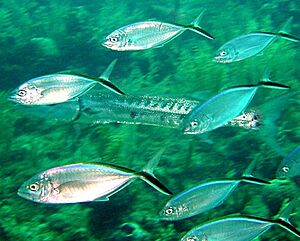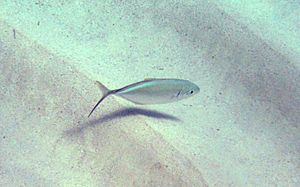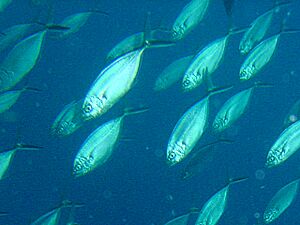Bar jack facts for kids
Quick facts for kids Bar jack |
|
|---|---|
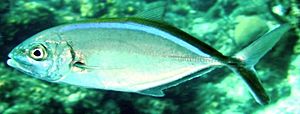 |
|
| Conservation status | |
| Scientific classification | |
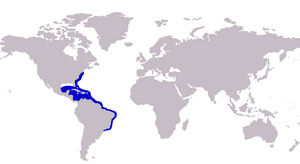 |
|
| Approximate range of the bar jack | |
| Synonyms | |
|
The bar jack (Caranx ruber) is a cool fish that lives in the ocean, usually near the coast. It's also known by other names like carbonero or red jack. This fish belongs to the jack family, called Carangidae. You can find bar jacks in the western Atlantic Ocean, from New Jersey all the way down to Venezuela. They are most common in the Gulf of Mexico and the Caribbean.
It's easy to spot a bar jack because of the dark stripe that runs along its back and tail fin. Often, there's also a bright electric blue stripe right below the dark one. Bar jacks can grow quite large, up to 65 cm long and weighing about 6.8 kg. They like clear, shallow waters, especially around coral reefs. They might swim alone or in big schools. Bar jacks eat smaller fish, crustaceans (like shrimp), and cephalopods (like squid). In places like Cuba, they lay their eggs between March and August. People enjoy catching bar jacks for sport, and they are considered good to eat. However, sometimes they can carry a toxin called ciguatera, which can make people sick.
Contents
About the Bar Jack's Name
The bar jack is part of a group of fish called Caranx, which includes many types of jacks. This group is part of the larger jack and horse mackerel family, Carangidae.
The first scientific description of the bar jack was made by Marcus Elieser Bloch in 1793. He named it Somber ruber. The name Caranx comes from a French word for a Caribbean fish. The word ruber is Latin for red. So, its scientific name Caranx ruber basically means "red jack."
Besides "bar jack," this fish has other common names like blue-striped cavalla, red jack, neverbite, and passing jack.
What Does a Bar Jack Look Like?
The bar jack is a medium-sized fish. It can grow up to 69 cm long and weigh up to 6.8 kg. But usually, you'll see them around 40 cm long. They have a typical jack shape: long, a bit flat on the sides, and not too thick.
Their top fin (dorsal fin) has two parts. The first part has 8 stiff spines, and the second has 1 spine and 26 to 30 soft rays. The bottom fin (anal fin) has 2 separate spines, then 1 spine and 23 to 26 soft rays. Their side fins (pectoral fins) are long and curved.
A special feature of the bar jack is its scales. Its chest is completely covered in scales. This helps tell it apart from other similar jacks. Its mouth has many small teeth, and the upper jaw has some bigger, curved teeth.
The bar jack's upper body is gray to bluish-gray with a shiny silver look, fading to a white belly. The most noticeable part is the dark, golden-brown to black stripe that runs along its back and into the lower part of its tail fin. Often, a bright electric blue stripe runs right underneath this dark bar. All its other fins are light or clear. Young bar jacks have up to 6 dark stripes on their body. When they are feeding near the bottom, their whole body can turn a darker, blackish color.
Where Do Bar Jacks Live?
Bar jacks live in the warm, tropical and subtropical waters of the western Atlantic Ocean. You can find them from New Jersey in the north, all the way down to Venezuela. They also live around many islands like Bermuda and in the Caribbean. They are most common in the Gulf of Mexico and the Caribbean Sea.
These fish usually live in clear, shallow waters, often around coral reefs. They can be found at depths of about 60 ft. Studies show that bar jacks move around a lot. They don't stay in one spot for long. They often travel between different reefs over large sandy areas. Bar jacks sometimes swim into calm lagoons from the open ocean. They prefer to move over sandy bottoms in these shallow areas. They might even swim with other fish like barracudas, stingrays, and sharks. Young bar jacks often hide under floating mats of sargassum seaweed for protection. They also like to hang out around docks and pilings.
Bar Jack Life and Habits
Scientists have studied what bar jacks eat and how they reproduce, especially in the waters near Cuba. Bar jacks are often hunted by bigger fish like other jacks, dolphinfish, mackerels, and marlins, as well as by seabirds.
What Bar Jacks Eat
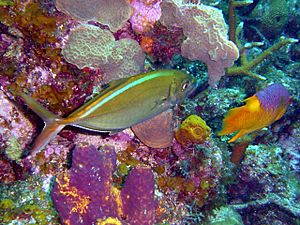
Bar jacks are predators that hunt both in the open water and near the seafloor. Their diet is mostly made up of other fish, sometimes up to 90% of what they eat. They also eat smaller amounts of tiny planktonic crustaceans and small cephalopods like squid.
What they eat changes as they get older. Young bar jacks prefer to eat tiny plankton, like decapod and fish larvae. As they grow, they start eating shrimp and small fish. Adult bar jacks eat almost only small fish. They often target small fish that live in the sand, like blennies and gobies. They also eat small reef fish like wrasses, butterflyfish, and filefish. Eating these reef fish can sometimes lead to the bar jack carrying the ciguatera toxin.
Their feeding habits change throughout the year, depending on the weather. Young fish eat a lot all year, but especially in spring and autumn. Adult fish eat more during the dry and rainy seasons.
How Bar Jacks Reproduce
Bar jacks lay their eggs twice a year. This usually happens when they have eaten a lot and built up fat. In Cuba, they lay eggs between March and August, with the busiest times in March–April and June–July.
Hundreds of bar jacks gather in schools to spawn. Pairs of fish then break away to lay their eggs. A female bar jack can release between 67,000 and 231,000 eggs. The eggs are fertilized outside her body. These tiny eggs float in the water and are about 0.75 mm to 0.85 mm wide. They hatch when the larvae are about 2 mm long.
Young bar jacks grow fastest during their first three years. They look very similar to another fish called the yellow jack when they are young. They often hide in floating mats of Sargassum seaweed, which gives them protection. Young fish live in shallow reef waters, but they move to deeper waters once they are old enough to reproduce. Males become ready to reproduce when they are about 25 cm long, and females when they are about 31 cm long.
Bar Jacks and People
The bar jack is somewhat important for fishing, both for commercial fishermen and for people who fish for fun. Long ago, native people in the Bahamas caught bar jacks for food. Today, many bar jacks are caught, but they are usually not the main fish caught by large fishing boats. The United States reports catching only a small amount each year. However, more are caught in the Caribbean where they are very common.
Bar jacks can be a bit shy of hooks with bait. So, they are mostly caught using large nets like trawls and seines. They are sold fresh in places like the Antilles and Bahamas. Many people think they taste good.
For recreational fishermen, the bar jack is a popular game fish. They are fun to catch on light fishing gear using small lures or flies. They are known to fight hard when caught. Sometimes, you can see them chasing small baitfish to the surface, which is a good time to try to catch them. Bar jacks are also used as bait for much larger game fish like marlin and sailfish. The world record for a bar jack caught by a fisherman was 3.32 kg (7 lb 5oz).
It's important to know that bar jacks can sometimes carry a toxin called ciguatera in their meat. This toxin can make people sick if they eat the fish. Experts say bar jacks have a medium risk of carrying this toxin. In the Virgin Islands, many cases of ciguatera poisoning have been linked to eating bar jacks.
See also
 In Spanish: Carangoides ruber para niños
In Spanish: Carangoides ruber para niños



